Divine proportions
“Proportion is not only to be found in numbers and measures, but also in sounds, weights, intervals of time, and in every active force in existence.”
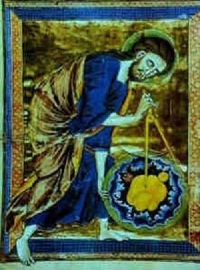
- God the Creator as Divine Geometer
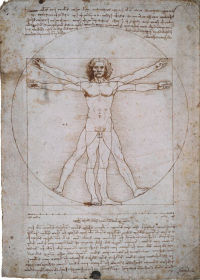
- The proportions of the human body in the manner of Vitruvius (The Vitruvian Man) © Ministero per i Beni e le Attività Culturali, Polo Museale Veneziano
God's most perfect creation
The belief that mathematical law governs everything in the universe goes back to before the time of Plato. During medieval times, God was seen as a sort of divine “geometer” who created everything on the basis of number and proportion.All of Leonardo’s investigations regarding natural phenomena were carried out with a firm belief in the mathematical principles underlying all forms. One might even say that he “thought” in terms of proportions – sound, light, the shapes and dimensions of all living things, all were believed to be governed by “omnipresent measure” or divine proportion.
Because man was seen as God’s most perfect creation, harmonic proportions were also believed to govern the human form. In his drawing of Vitruvian Man, Leonardo illustrated Vitruvius’s principle that a well-built man with hands and feet extended fits perfectly into a circle and a square.
Leonardo had to manipulate things a little to make the principle work. The circle is centred on the navel, but the centre of the square is positioned lower. He also altered the measurements of the human body as supplied by Vitruvius in his treatise and applied his own measurements based on his study of the life model. Nonetheless, the image is now accepted as a true representation of Vitruvius’ findings, and a credible image of the ideal proportions of the human body.

- Codex Ashburnham Fol. 93v - Designs for a centrally planned church. Photo RMN - © René-Gabriel Ojéda

- Santa Maria della Croce, Cremona
An ideal building
According to Vitruvius, an ideal building was one governed by the proportions of the human body. Alberti believed that harmonious measure governs our very souls. We intuitively sense when the building we are in is harmoniously proportioned according to natural law. Renaissance architects from Brunelleschi to Bramante took all of this on board, and the ideas manifested themselves particularly in the form of designs for centrally planned churches, which they saw as the epitome of divine proportion.During the late 1480s in Milan, Leonardo thought at length about churches with centralised plans. Major projects under discussion at that time, including a new Cathedral for Pavia and the choir of Santa Maria delle Grazie, may have stimulated his interest in architecture.
All of his churches, such as those on Codex Ashburnham Fol 93v are expressed as three-dimensional “organic” spatial volumes, drawn from a bird’s eye view. Each is accompanied by a ground plan, as if to illustrate the “roots” from which each has grown. The designs are mainly derived from configurations of circles and the squares, the perfect geometric forms. Most comprise of a central area surmounted by a large dome with a small lantern, surrounded by chapels. This configuration offered the greatest possibility for invention and allowed Leonardo to achieve maximum unity and variety. It may have been inspired by Brunelleschi’s work in Florence – the unfinished church of Santa Maria degli Angeli and the dome and lantern of Florence Cathedral.
While Leonardo’s designs were never built, his ideas regarding centrally planned religious buildings had a profound effect on his friend the architect Donato Bramanate. Bramante’s reconstruction of the east-end of Santa Maria delle Grazie in Milan transformed the interior into a magnificent centralized space that exudes a feeling for Euclidean geometry. The exterior massing of geometric volumes is highly reminiscent of Leonardo’s designs in Ms.B. His proposed design for the new Basilica of St. Peters, which was originally based on a centralised plan also exhibits the same sense of organic unity that pervades Leonardo’s architectural designs.
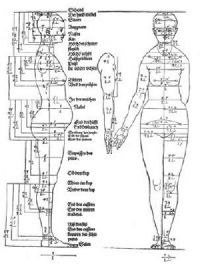
- Albrecht Dürer, Studies on the proportions of the female body, 1528, Woodcut
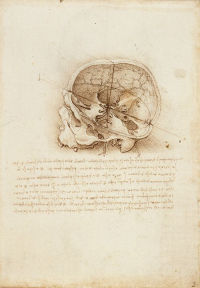
- A skull sectioned The Royal Collection © 2005, Her Majesty Queen Elizabeth II
Harmony and humanity
While Leonardo realized that every figure is different, all were believed to be governed by the same underlying principles of harmony that governed the universe. The microcosm of the human body was mirrored in the macrocosm of the universe and vice versa.Renaissance theorists had long been occupied by the search for human proportionality. Alberti, in his treatise “On Statuary” described detailed measuring techniques for determining the relations of each part of the human body to the other and to the whole.
Judging from Leonardo’s surviving manuscripts, his planned treatise “On the human body” although never realised, would have gone well beyond any previous investigation of the human body. In a remarkable series of Studies of the human skull, dated c1489, Leonardo investigated the architecture of the human skull. The main axes of the skull are sectioned just as some of the church designs in his architectural drawings, in order to locate the position of the human soul within. Leonardo locates it at the point where the proportional axes of the skull intersect.
The lengths to which Leonardo went in order to establish the universal nature of his theory of proportion was unprecedented. He refined modules for the human body at rest and in motion and for detailed parts of the body, as in his Study of the facial proportions of a man seen in profile. He also investigated the proportions of women and children, and may have even written a treatise on proportions, now lost, which is mentioned in the Treatise on Painting.
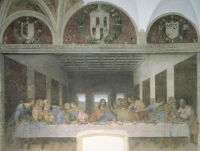
- Last Supper © SPSAE, Milano
The science of painting
Proportion was a means towards the rational and mathematically correct portrayal of nature that made painting a science. Linear perspective, as the surest means of achieving correct and natural proportion in painting, became the new “science-art” of the 15th century.Analysis of the perspective of the Last Supper suggests that Leonardo applied a system of harmonic proportions found in music to the construction of the picture’s architectural space. The base of the painting is divided into 12 units and the ceiling into 6 parts along the top. The height from uppermost stucco molding to the horizontal bottom line is half the width, equivalent to 6 units. The width of the rear wall is one third of the whole, or 4 units. The proportioning of the widths of the tapestries on the side-walls (which have lost their design and now appear as blank rectangles) follows the ratio 12:6:4:3.
These proportions find an analogy in the theory of music. 3:4 is the tonal interval of a fourth; 4:6 a fifth and 6:12 and octave, the only intervals considered harmonious by the ancient Greeks. The fact that Leonardo made a note of a number sequence of a similarly harmonic numbers on an early preparatory sketch for the Last Supper now at Windsor would appear to confirm his intentions.
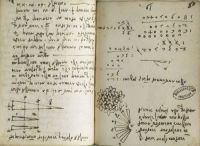
- Ms L Fol 79v-80r Photo RMN - © René-Gabriel Ojéda
Music
According to Leonardo, the musician composes harmony by the simultaneous conjunction of its “proportional parts”. The painter “grades the things before the eye as music grades the sounds that meet the ear”. On Ms. L. Fol 79v. Leonardo investigates sound and tries to establish strict mathematical proportions between the loudness of a sound at its origin and its range, the point in space up to which it can be heard. This “pyramidal law” was seen as a universal law of proportion that could be applied to other natural phenomena such as light, perspective and even mechanics.Leonardo’s pyramidal law of proportional diminution did not always lead to fruitful conclusions. In the absence of knowledge of advanced mechanics, he attempted to apply it to the investigation of gravity, noting that every falling object acquires increments of impetus. He was obviously unaware of the Merton “mean speed theorem” which states that a body traveling at constant velocity will cover the same distance in the same time as an accelerated body if its velocity is half the final speed of the accelerated body.
Undeterred, Leonardo investigated the actions of levers, pulleys and balances at length according to medieval proportional laws, illustrating endless demonstrations of harmonic equilibrium. While most of the results had no practical purpose, Leonardo seems to have taken delight in demonstrating the certainty of proportional law for its own sake. Perhaps it confirmed his view of the inter-connectedness of all things in nature, which he so often disproved in the course of testing theory with experiment.





